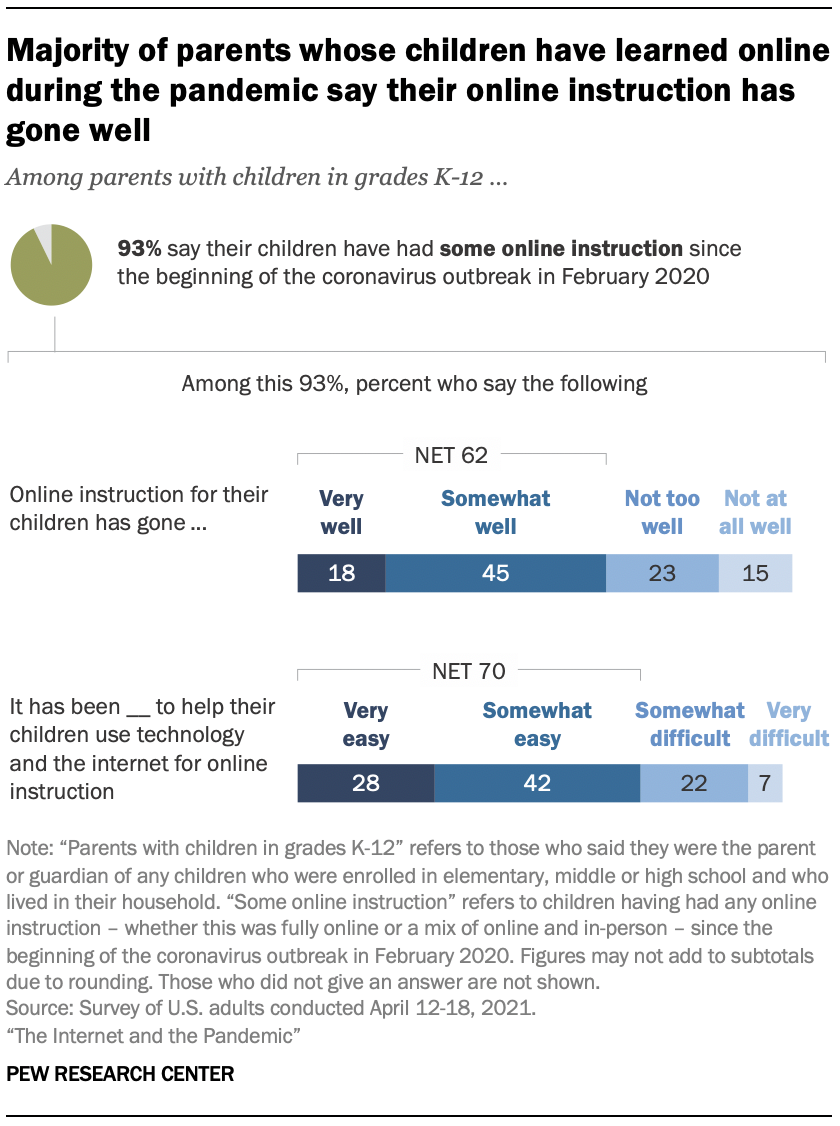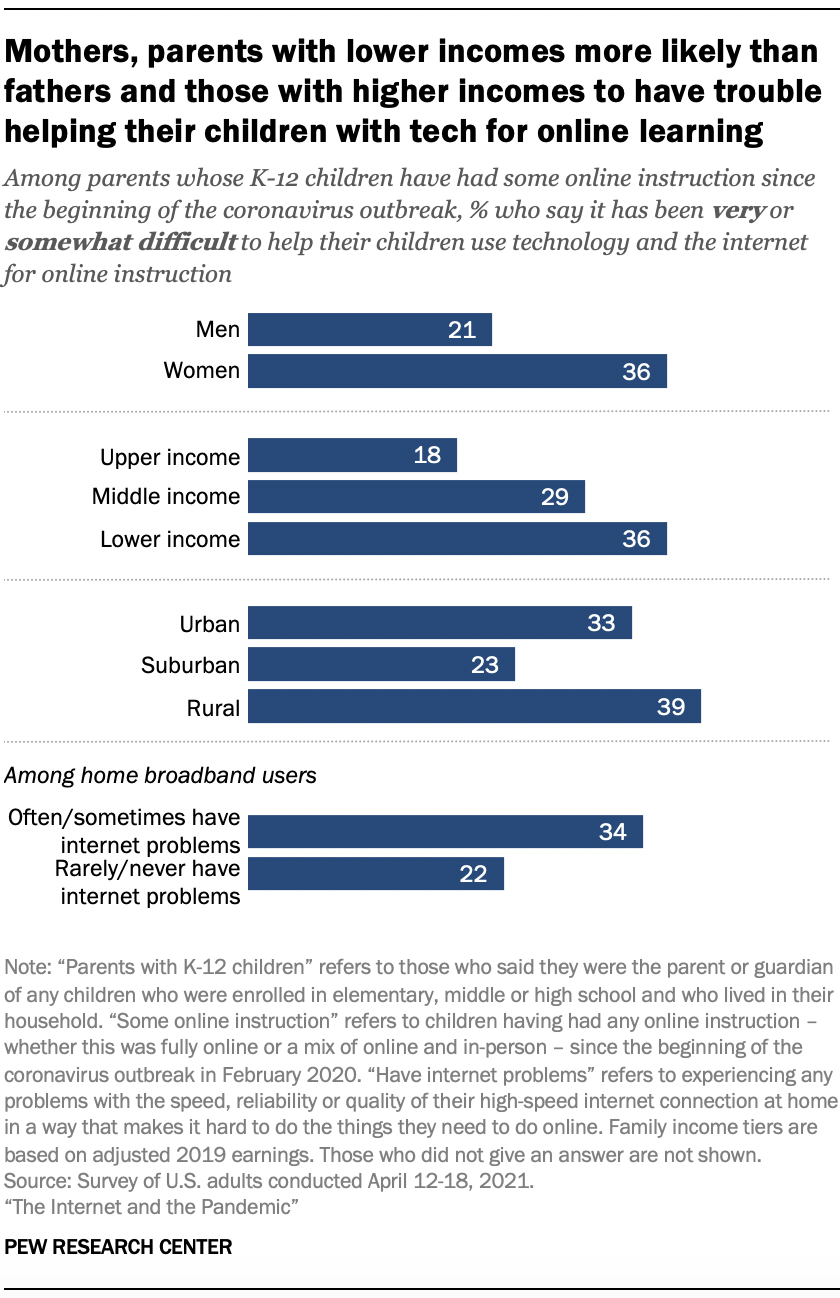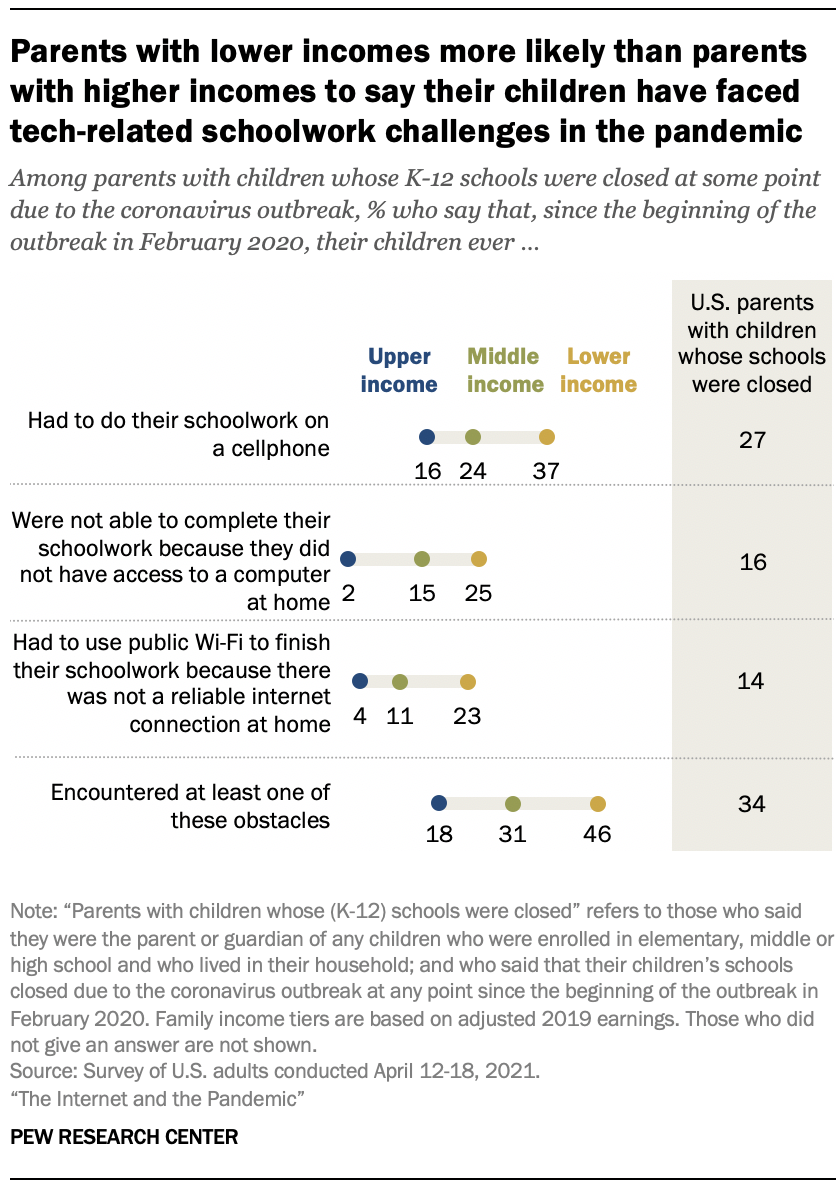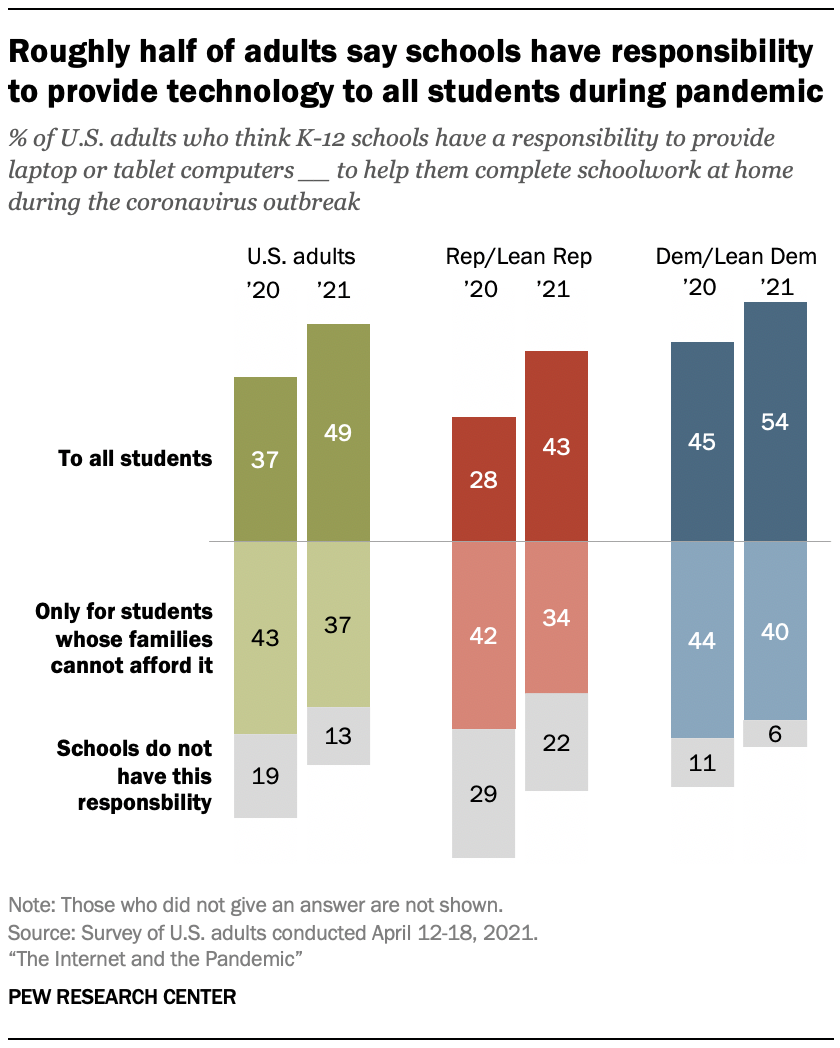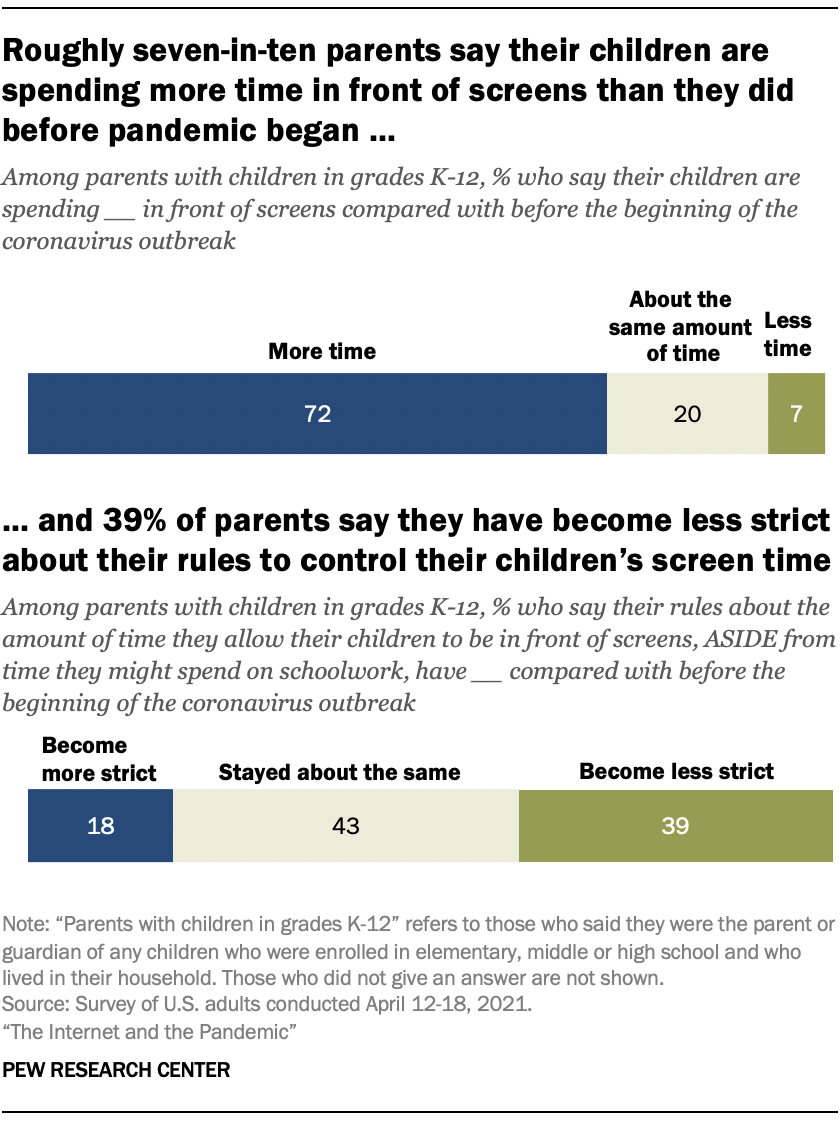The COVID-19 pandemic disrupted the lives of families with school-age children in a major way. The coronavirus forced widespread school closings across the United States, and many parents had to work with their children to adjust to online learning.
This survey finds that 93% of parents with children in grades K-12 say their children have had some online instruction since the beginning of the coronavirus outbreak in February 2020. Majorities of these parents say they generally have had positive experiences when it comes to their children’s online learning.
Among parents whose children have had some online instruction during the pandemic, 62% say online instruction has gone very or somewhat well and 70% say they have had a very or somewhat easy experience helping their children use technology and the internet for online instruction.
Still, 30% of parents whose children have had any online instruction since the beginning of the coronavirus outbreak say they have had a very or somewhat difficult time helping their children use technology and the internet for this purpose. Certain groups of these parents are particularly likely to say they have had a difficult time helping their children with online learning. For example, 36% of mothers of children who learned online say they had a very or somewhat difficult time helping their children with technology and the internet for online instruction, compared with 21% of fathers.
This challenge is also prevalent for parents in certain types of communities – 39% of rural residents and 33% of urban residents say they have had at least some difficulty, compared with 23% of suburban residents. And those with lower and middle incomes are more likely than those with higher incomes to report this difficulty.
Among broadband users, connection quality also plays a role in parents’ experience in helping their children with online learning.
Some 34% of parents who say they often or sometimes experience internet problems also say they have a relatively difficult time helping their children with technology and the internet for online instruction, compared with 22% of parents who never or rarely have internet problems.
Parents with lower incomes more likely than parents with higher incomes to say their children had technology-related difficulties with schoolwork
This survey, which follows up on findings reported near the beginning of the pandemic about the problems parents thought their children might face, shows that some parents report that their children have faced technology-related difficulties while completing school assignments since the coronavirus outbreak began.
The April 2021 survey shows that roughly a quarter (27%) of parents with children whose schools were closed at some point during the pandemic say their children had to do their schoolwork on a cellphone. Smaller shares of these parents say their children were unable to complete schoolwork because they did not have access to a computer at home (16%) or had to use public Wi‑Fi to finish their schoolwork because there was not a reliable internet connection at home (14%). And roughly a third (34%) of parents whose children’s schools were closed at some point say their children encountered at least one of these three challenges in trying to complete their schoolwork.
The shares among these parents with children whose schools closed at some point vary based on household income and show that parents with lower incomes were more likely to report their children had these tech-related problems. For instance, 25% of parents with lower incomes say their children with closed schools could not complete their schoolwork because of a lack of computer access. This share is 23 percentage points higher than for parents who have higher incomes (2%). Parents with lower incomes are also far more likely than those in the upper-income tier to say their children encountered at least one of these obstacles during the pandemic (46% vs. 18%). And 9% of these parents in lower-income households say their children experienced all three of these obstacles.
In a survey near the beginning of the pandemic last year, the Center asked parents about whether they anticipated these problems for their children. In April 2020, 29% of parents with children whose schools were closed at that time said it was very or somewhat likely that in completing schoolwork at home during the coronavirus outbreak, their children would have to do their schoolwork on a cellphone. About one-in-five of the same set of parents said this about children having to use public Wi-Fi to finish their schoolwork because of a lack of a reliable internet connection at home or being unable to complete their schoolwork because they did not have access to a computer at home. And 38% of these parents said their children would be very or somewhat likely to encounter at least one of these tech-related obstacles for schoolwork.
Growing share of adults say schools should provide technology to all students in order to complete schoolwork during the pandemic
Since the pandemic began, public attitudes have shifted and become more supportive of the idea that schools have a responsibility to provide all students with laptop or tablet computers to help them complete schoolwork during the pandemic.
The new survey finds that 49% of U.S. adults say that K-12 schools have a responsibility to provide all students with laptop or tablet computers in order to help them complete their schoolwork at home during the COVID-19 outbreak – a 12 percentage point increase from April 2020. At the same time, the share of Americans who say otherwise has decreased since last year. The portions who say schools only have a responsibility for students whose families cannot afford technology and that schools do not have this responsibility each fell by 6 points.
While larger shares of both parties now say K-12 schools have a responsibility to provide computers to all students in order to help them complete schoolwork at home, there is a 15-point change among Republicans: 43% of Republicans now say K-12 schools have this responsibility, compared with 28% last April. In the new survey, 22% of Republicans also say schools do not have this responsibility at all, compared with 6% of Democrats. And Democrats are still more likely than Republicans to say K-12 schools have a responsibility to provide computers to all students to help them complete schoolwork at home.
Adults with lower incomes are also more likely than those who have middle or higher incomes to say K-12 schools should provide technology to all students. And adults in lower-income households who say this have seen a 10-point increase since 2020.
Majority of parents of K-12 children say their kids are spending more time in front of screens; 39% say they have become less strict about screen time
As many parents settled at home and adjusted to online learning for their children, a majority observed changing screen time patterns for their children.
Compared with before the beginning of the coronavirus outbreak, 72% of parents with children in school say their children are spending more time in front of screens. By contrast, 7% of these parents say their children are spending less time in front of screens now, and 20% say they spend about the same amount of time as before the pandemic.
For some, these pandemic realities played a role in new rules about screen time. Even as a majority of parents with children in grades K-12 say their children are spending more time in front of screens, a share of parents with children in school also say they have become less strict about screen time control. Some 39% of these parents say they have become less strict with their rules about the amount of time they allow their children to be in front of screens – aside from time they might spend on schoolwork – compared with before the beginning of the pandemic. A smaller share of parents with children in grades K-12 say they have become more strict (18%) with these rules. And 43% say their rules have stayed about the same.
There is some variation in how parents with children in grades K-12 have changed their screen time rules based on where they live. Suburban parents (45%) are more likely than rural (34%) or urban parents (33%) to say they have become less strict about the amount of non-schoolwork time they allow their children to be in front of screens compared with before the pandemic.


